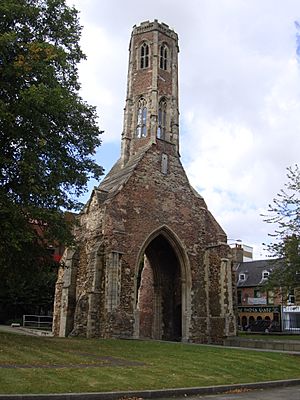Greyfriars, King's Lynn facts for kids
Greyfriars Tower in King's Lynn, Norfolk, England, is a really old and important building. It's the last part of a Franciscan friary, which was like a monastery for a group of monks called Franciscans. This tower is special because it's one of only three Franciscan monastery towers still standing in England, and many people think it's the best one! It's also a "Grade I listed building," which means it's super important historically.
The tower is sometimes called 'the leaning tower of Lynn' because it tilts quite a bit to the west. At its most tilted, it leaned 67.5 centimetres! That's just over 1 degree for a tower more than 28 metres tall. To compare, the famous Leaning Tower of Pisa leans about 3.98 degrees.
Contents
Greyfriars Tower: A Historic Landmark
Greyfriars Tower stands tall in King's Lynn. It's a reminder of a time long ago when friars lived and worked here. The tower is a key part of the town's history and its skyline.
Why the Tower Still Stands
Hundreds of years ago, a king named Henry VIII made big changes in England. He closed down many monasteries and friaries, a time known as the Dissolution of the Monasteries. Most buildings were pulled down. However, Greyfriars Tower was saved! Why? Because sailors used it as a very helpful landmark. It guided their ships into the town's port. Even today, you can still see it clearly from far away.
The Famous Lean of Lynn
The tower's lean makes it very unique. It's not as famous as the Leaning Tower of Pisa, but it's still quite noticeable! Engineers have studied the lean carefully. They found that while it leans, it's not in danger of falling over.
Saving the Tower: Restoration Work
For many years, the tower needed some help to keep it safe. Work was done to fix the lean and make sure it stays strong. This important project was finished by August 2006.
The tower even appeared on a BBC TV show called Restoration. This show helped raise money and awareness for old buildings. Greyfriars Tower won its regional competition. It then went on to the national final, but the Victoria Baths in Manchester won that year. On October 18, 2006, the area around the tower was officially opened to the public.


